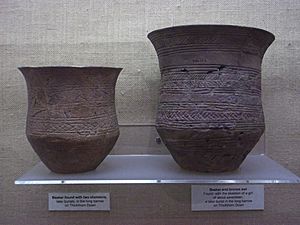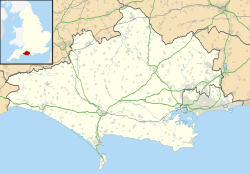Thickthorn Down Long Barrows facts for kids

Bell-beakers found with secondary burials in the excavated barrow on Thickthorn Down. In the Dorset County Museum.
|
|
| Location | near Gussage St Michael, Dorset |
|---|---|
| Coordinates | 50°54′36″N 2°2′31″W / 50.91000°N 2.04194°W |
| History | |
| Periods | Neolithic |
| Site notes | |
| Excavation dates | 1933 |
| Archaeologists | Stuart Piggott, C. D. Drew |
| Designated | 24 March 1958 |
| Reference no. | 1002708 |
The Thickthorn Down Long Barrows are two very old burial mounds. They were built by people living in Britain during the Stone Age. These special mounds are found near a village called Gussage St Michael in Dorset, England.
They are also close to a huge ancient earthwork called the Dorset Cursus. The long barrows are protected as a scheduled monument, which means they are important historical sites.
Contents
What Are the Thickthorn Down Long Barrows?
The two long barrows are located on a hill called Thickthorn Down. They are ancient burial places.
The Unexcavated Barrow
One of the barrows is on the north-west side. It has not been dug up by archaeologists. This barrow is shaped like a rectangle. It is about 44 meters long and 18 meters wide. It stands about 2.4 meters high. There is a ditch around part of this mound.
This barrow lines up with the end of the Dorset Cursus. The Cursus is a very long, ancient earthwork. Experts think the end of the Cursus was built to connect with this barrow.
The Excavated Barrow
The second barrow is a short distance away, to the south-east. It also runs from north-west to south-east. This mound is also rectangular. It is about 30 meters long and 18 meters wide. It is also about 2.4 meters high.
This barrow has a ditch around it, too. However, there is a gap in the ditch at the south-east end. This gap is like a pathway, called a causeway.
Digging Up the Past: The Excavation
The south-eastern barrow was carefully dug up in 1933. Two archaeologists, C. D. Drew and Stuart Piggott, led the work. After their study, the barrow was carefully put back together.
What Did They Find?
The archaeologists found three holes for wooden posts on the causeway. One of these was right in the middle of the mound. They did not find any original burials from when the mound was first built.
In the center of the mound, they found a special structure. It was made of two walls of turf (grass and soil). The space between these walls was filled with chalk rubble. The people who dug it up first thought this structure was built before the mound.
However, more recent ideas suggest the mound was built in sections. These sections might have been divided by fences or hurdles.
Later Burials and Pottery
Archaeologists found three later burials on the south-west side of the mound. These were added after the barrow was first built. Two of these burials had special ancient cups with them. These cups are called beakers.
In the ditch around the barrow, they found different layers of soil. These layers contained various items. They found pottery from the Early Neolithic period. They also found later pottery known as Peterborough ware. These finds help us understand when people used the barrow.


